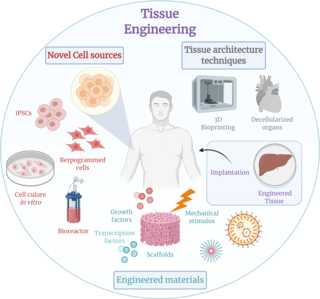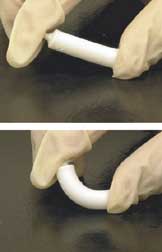Related Research Articles

Biopolymers are natural polymers produced by the cells of living organisms. Like other polymers, biopolymers consist of monomeric units that are covalently bonded in chains to form larger molecules. There are three main classes of biopolymers, classified according to the monomers used and the structure of the biopolymer formed: polynucleotides, polypeptides, and polysaccharides. The Polynucleotides, RNA and DNA, are long polymers of nucleotides. Polypeptides include proteins and shorter polymers of amino acids; some major examples include collagen, actin, and fibrin. Polysaccharides are linear or branched chains of sugar carbohydrates; examples include starch, cellulose, and alginate. Other examples of biopolymers include natural rubbers, suberin and lignin, cutin and cutan, melanin, and polyhydroxyalkanoates (PHAs).

Tissue engineering is a biomedical engineering discipline that uses a combination of cells, engineering, materials methods, and suitable biochemical and physicochemical factors to restore, maintain, improve, or replace different types of biological tissues. Tissue engineering often involves the use of cells placed on tissue scaffolds in the formation of new viable tissue for a medical purpose, but is not limited to applications involving cells and tissue scaffolds. While it was once categorized as a sub-field of biomaterials, having grown in scope and importance, it can is considered as a field of its own.

Nanofibers are fibers with diameters in the nanometer range. Nanofibers can be generated from different polymers and hence have different physical properties and application potentials. Examples of natural polymers include collagen, cellulose, silk fibroin, keratin, gelatin and polysaccharides such as chitosan and alginate. Examples of synthetic polymers include poly(lactic acid) (PLA), polycaprolactone (PCL), polyurethane (PU), poly(lactic-co-glycolic acid) (PLGA), poly(3-hydroxybutyrate-co-3-hydroxyvalerate) (PHBV), and poly(ethylene-co-vinylacetate) (PEVA). Polymer chains are connected via covalent bonds. The diameters of nanofibers depend on the type of polymer used and the method of production. All polymer nanofibers are unique for their large surface area-to-volume ratio, high porosity, appreciable mechanical strength, and flexibility in functionalization compared to their microfiber counterparts.

The Institute of Materials, Minerals and Mining (IOM3) is a British engineering institution with activities including materials exploration, extraction, characterisation, processing, forming, finishing, application, product recycling and land reuse. Its stated goal is to promote and develop all aspects of materials science and engineering, geology, mining, mineral and petroleum engineering, and extractive metallurgy.
Kyriacos A. Athanasiou is a Greek Cypriot-American bioengineer who has contributed significantly to both academic advancements as well as high-technology industries. He is currently a Distinguished Professor at the University of California, Irvine. He joined UCI from the University of California, Davis where he also served as the Chair of the Biomedical Engineering department. Before joining the University of California in 2009, he was the Karl F. Hasselmann Professor at Rice University. He has published hundreds of scientific articles detailing structure-function relationships and tissue engineering approaches for articular cartilage, the knee meniscus, and the temporomandibular joint.

Artificial skin is a collagen scaffold that induces regeneration of skin in mammals such as humans. The term was used in the late 1970s and early 1980s to describe a new treatment for massive burns. It was later discovered that treatment of deep skin wounds in adult animals and humans with this scaffold induces regeneration of the dermis. It has been developed commercially under the name Integra and is used in massively burned patients, during plastic surgery of the skin, and in treatment of chronic skin wounds.

Artificial bone refers to bone-like material created in a laboratory that can be used in bone grafts, to replace human bone that was lost due to severe fractures, disease, etc.
A fibrin scaffold is a network of protein that holds together and supports a variety of living tissues. It is produced naturally by the body after injury, but also can be engineered as a tissue substitute to speed healing. The scaffold consists of naturally occurring biomaterials composed of a cross-linked fibrin network and has a broad use in biomedical applications.
Acellular dermis is a type of biomaterial derived from processing human or animal tissues to remove cells and retain portions of the extracellular matrix (ECM). These materials are typically cell-free, distinguishing them from classical allografts and xenografts, can be integrated or incorporated into the body, and have been FDA approved for human use for more than 10 years in a wide range of clinical indications.

Heparan sulfate analogues are polymers engineered to mimic several properties of heparan sulfates. They can be constituted with a backbone of polysaccharides, such as poly glucose or glucuronates or a polyester such as co polymers of lactic or malic acid to which sulfates, sulfonate or carboxyl groups are added in controlled amounts and location. They have a molecular weight that can range from a few thousand to several hundred thousand Dalton. Heparan sulfates can sequester growth factors (GFs) and cytokines in the extracellular matrix (ECM) thereby protecting them from degradation. This ensures local presence of these signaling proteins to fulfill their function in the ECM which contributes to the preservation of anatomical form and function. Heparan sulfates bind to matrix proteins on specific sites called "heparan sulfate binding sites" on ECM macromolecules like collagen, fibronectin and laminin, to form a scaffold surrounding the cells and to protect ECM proteins and growth factors from proteolytic degradation by steric hindrance. However, at any site of inflammation, so also in wound areas, heparan sulfates are degraded, mainly by heparanases giving free access to protease to degrade the ECM and a subsequent loss of GFs and cytokines that disrupts the normal tissue homeostasis. Heparan sulfate analogues obtain many of the characteristics of heparan sulfates including the ability to sequester GFs and bind and protect matrix proteins. However, heparan sulfate analogues are resistant to enzymatic degradation. This way they strengthen the healing potential of the wound bed by repositioning GFs and cytokines back into the ECM.
Tissue engineering of oral mucosa combines cells, materials and engineering to produce a three-dimensional reconstruction of oral mucosa. It is meant to simulate the real anatomical structure and function of oral mucosa. Tissue engineered oral mucosa shows promise for clinical use, such as the replacement of soft tissue defects in the oral cavity. These defects can be divided into two major categories: the gingival recessions which are tooth-related defects, and the non tooth-related defects. Non tooth-related defects can be the result of trauma, chronic infection or defects caused by tumor resection or ablation. Common approaches for replacing damaged oral mucosa are the use of autologous grafts and cultured epithelial sheets.

Decellularization is the process used in biomedical engineering to isolate the extracellular matrix (ECM) of a tissue from its inhabiting cells, leaving an ECM scaffold of the original tissue, which can be used in artificial organ and tissue regeneration. Organ and tissue transplantation treat a variety of medical problems, ranging from end organ failure to cosmetic surgery. One of the greatest limitations to organ transplantation derives from organ rejection caused by antibodies of the transplant recipient reacting to donor antigens on cell surfaces within the donor organ. Because of unfavorable immune responses, transplant patients suffer a lifetime taking immunosuppressing medication. Stephen F. Badylak pioneered the process of decellularization at the McGowan Institute for Regenerative Medicine at the University of Pittsburgh. This process creates a natural biomaterial to act as a scaffold for cell growth, differentiation and tissue development. By recellularizing an ECM scaffold with a patient’s own cells, the adverse immune response is eliminated. Nowadays, commercially available ECM scaffolds are available for a wide variety of tissue engineering. Using peracetic acid to decellularize ECM scaffolds have been found to be false and only disinfects the tissue.

Melt electrospinning is a processing technique to produce fibrous structures from polymer melts for applications that include tissue engineering, textiles and filtration. In general, electrospinning can be performed using either polymer melts or polymer solutions. However, melt electrospinning is distinct in that the collection of the fiber can very focused; combined with moving collectors, melt electrospinning writing is a way to perform 3D printing. Since volatile solvents are not used, there are benefits for some applications where solvent toxicity and accumulation during manufacturing are a concern.
Lori Ann Setton is an American biomechanical engineer noted for her research on mechanics and mechanobiology of the intervertebral disc, articular cartilage mechanics, drug delivery, and pathomechanisms of osteoarthritis. She is currently the department chair as well as the Lucy and Stanley Lopata Distinguished Professor of Biomedical Engineering at McKelvey School of Engineering at Washington University in St. Louis.

Self-healing hydrogels are a specialized type of polymer hydrogel. A hydrogel is a macromolecular polymer gel constructed of a network of crosslinked polymer chains. Hydrogels are synthesized from hydrophilic monomers by either chain or step growth, along with a functional crosslinker to promote network formation. A net-like structure along with void imperfections enhance the hydrogel's ability to absorb large amounts of water via hydrogen bonding. As a result, hydrogels, self-healing alike, develop characteristic firm yet elastic mechanical properties. Self-healing refers to the spontaneous formation of new bonds when old bonds are broken within a material. The structure of the hydrogel along with electrostatic attraction forces drive new bond formation through reconstructive covalent dangling side chain or non-covalent hydrogen bonding. These flesh-like properties have motivated the research and development of self-healing hydrogels in fields such as reconstructive tissue engineering as scaffolding, as well as use in passive and preventive applications.

Paul O'Brien was professor of Inorganic Materials at the University of Manchester. where he served as head of the School of Chemistry from 2004 to 2009 and head of the School of Materials from 2011 to 2015. He died on 16 October 2018 at the age of 64.
In 2016 the Women's Engineering Society (WES), in collaboration with the Daily Telegraph, produced an inaugural list of the United Kingdom's Top 50 Influential Women in Engineering, which was published on National Women in Engineering Day on 23 June 2016. The event was so successful it became an annual celebration. The list was instigated by Dawn Bonfield MBE, then Chief Executive of the Women's Engineering Society. In 2019, WES ended its collaboration with the Daily Telegraph and started a new collaboration with The Guardian newspaper.
Bio-inks are materials used to produce engineered/artificial live tissue using 3D printing. These inks are mostly composed of the cells that are being used, but are often used in tandem with additional materials that envelope the cells. The combination of cells and usually biopolymer gels are defined as a bio-ink. They must meet certain characteristics, including such as rheological, mechanical, biofunctional and biocompatibility properties, among others. Using bio-inks provides a high reproducibility and precise control over the fabricated constructs in an automated manner. These inks are considered as one of the most advanced tools for tissue engineering and regenerative medicine (TERM).
Ruth Cameron FInstP FIOM3 is a British materials scientist and professor at the University of Cambridge. She is co-director of the Cambridge Centre for Medical Materials. She studies materials that interact therapeutically with the body.

Ovine forestomach matrix (OFM) is a layer of decellularized extracellular matrix (ECM) biomaterial isolated from the propria submucosa of the rumen of sheep. OFM is used in tissue engineering and as a tissue scaffold for wound healing and surgical applications
References
- 1 2 "Serena Best | Department of Materials Science & Metallurgy". Msm.cam.ac.uk. Retrieved 29 June 2017.
- ↑ "List of Fellows - Best". Royal Academy of Engineering.
- ↑ "Cambridge scientists among those honoured by Queen | Anglia - ITV News". Itv.com. 16 June 2017. Retrieved 28 June 2017.
- ↑ "IOM3 welcomes new President Professor Serena Best CBE FREng CEng FIMMM". Institute of Materials, Minerals & Mining. Retrieved 2 January 2019.